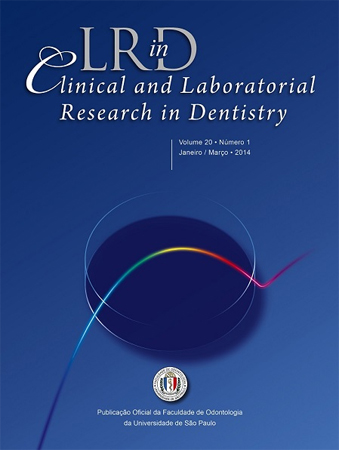The effects of ionizing radiation on the development of human caries lesions in vitro
DOI:
https://doi.org/10.11606/issn.2357-8041.v20i1p46-53Keywords:
Dental Caries, Head and Neck Neoplasms, Radiotherapy, Streptococcus mutans.Abstract
Radiotherapy is associated with several undesired side effects, such as rampant radiation caries. The aim of this study was to evaluate the effect of ionizing radiation on the development of carious lesions using a bacterial system in vitro. Fifteen sound human molars were selected and sectioned into buccal (A, control) and lingual (B, irradiated) dental fragments, which were considered dependent. Group B was submitted to radiotherapy according to the protocol for head and neck oncological treatment. The two groups were exposed to a cariogenic challenge using a bacterial system with S. mutans for 10, 20 and 30 days (n = 5). The variabels depth, extension and area for lesions formed at the enamel-dentin junction were measured by software coupled with light microscopy. Optical coherence tomography (OCT) was used to visualize the morphological characteristics of the lesions. Only the 20-day period of culture immersion for caries development resulted in signifi cantly better lesion comparisons, by light microscopy. Of the three lesion dimensions analyzed, lesion depth (lD) differed statistically between groups A and B (p = 0.013). Analysis using OCT allowed the visualization of carious lesions without showing the carious layers. Within the limitations of this study, we can conclude that radiation treatment of sound teeth before a cariogenic challenge in vitro causes deeper carious lesions than in those teeth not subjected to radiation treatment.Downloads
References
Brazil. Ministry of Health. National Institute of Cancer
José Alencar Gomes da Silva. Estimate/2012 - Cancer Incidence in Brazil [Internet]. Rio de Janeiro: Inca; 2011 [cited 2013 May 23]. Available from: URL:http://www.saude.sp.gov.
br/resources/ses/perfil/gestor/homepage/estimativas-deincidencia-de-cancer-012/estimativas_incidencia_cancer_
pdf.
Moore S, Burke MC, Fenlon MR, Banerjee A. The role of
the general dental practitioner in managing the oral care
of head and neck oncology patients. Dent Update. 2012
Dec;39(10):694-6,698-700,702.
Thariat J, Ramus L, Darcourt V, Marcy PY, Guevara N, Odin G, et al. Compliance with fluoride custom trays in irradiated head and neck cancer patients. Support Care Cancer. 2012 Aug;20(8):1811-4.
Aguiar GP, Jham BC, Magalhães CS, Sensi LG, Freire AR.
A review of the biological and clinical aspects of radiation
caries. J Contemp Dent Pract. 2009 Jul 1;10(4):83-9.
Jham BC, da Silva Freire AR. Oral complications of radiotherapy in the head and neck. Braz J Otorhinolaryngol.2006 Sep-Oct;72(5):704-8.
Meurman JH, Grönroos L. Oral and dental health care of oral cancer patients: hyposalivation, caries and infections. Oral Oncol. 2010 Jun;46(6):464-7.
Springer IN, Niehoff P, Warnke PH, Böcek G, Kovács G, Suhr M, et al. Radiation caries--radiogenic destruction of dentalcollagen. Oral Oncol. 2005 Aug;41(7):723-8.
Jham BC, Reis PM, Miranda EL, Lopes RC, Carvalho AL,
Scheper MA, et al. Oral health status of 207 head and neck
cancer patients before, during and after radiotherapy. Clin
Oral Investig. 2008 Mar;12(1):19-24.
Silva AR, Alves FA, Antunes A, Goes MF, Lopes MA. Patterns of demineralization and dentin reactions in radiation-related caries. Caries Res. 2009;43(1):43-9.
Silva AR, Alves FA, Berger SB, Giannini M, Goes MF, Lopes MA. Radiation-related caries and early restoration failure in head and neck cancer patients. A polarized light microscopy and scanning electron microscopy study. Support Care Cancer. 2010 Jan;18(1):83-7.
Poyton HG. The effects of radiation on teeth. Oral Surg Oral Med Oral Pathol. 1968 Nov;26(5):639-46.
Anneroth G, Holm E, Karlsson G. The effect of radiation on teeth. A clinical, histologic and microradiographic study. Int J Oral Surg. 1985 Jun;14(3):269-74.
Fränzel W, Gerlach R. The irradiation action on human dental tissue by X-rays and electrons -- a nanoindenter study. Z Med Phys. 2009;19(1):5-10.
Gama-Teixeira A, Simionato MR, Elian SN, Sobral MA,
Luz MA.Streptococcus mutans-induced secondary caries adjacent to glass ionomer cement, composite resin and
amalgam restorations in vitro. Braz Oral Res.2007 Oct-
Dec;21(4):368-74.
Espejo LC, Simionato MR, Barroso LP, Netto NG, Luz MA. Evaluation of three different adhesive systems using a bacterial method to develop secondary caries in vitro. Am J Dent. 2010 Apr;23(2):93-7.
Azevedo CS, Trung LC, Simionato MR, Freitas AZ, Matos AB. Evaluation of caries-affected dentin with optical coherence tomography. Braz Oral Res. 2011 Sep-Oct;25(5):407-13.
L ee C, Darling CL, Fried D. Polarization-sensitive optical
coherence tomographic imaging of artificial demineralization
on exposed surfaces of tooth roots. Dent Mater.
Jun;25(6):721-8.
Maia AM, Fonsêca DD, Kyotoku BB, Gomes AS. Characterization of enamel in primary teeth by optical coherence tomography for assessment of dental caries. Int J Paediatr Dent. 2010 Mar;20(2):158-64.
Specht L. Oral complications in the head and neck radiation patient. Introduction and scope of the problem. Support Care Cancer. 2002 Jan;10(1):36–9.
Downloads
Published
Issue
Section
License
Authors are requested to send, together with the letter to the Editors, a term of responsibility. Thus, the works submitted for appreciation for publication must be accompanied by a document containing the signature of each of the authors, the model of which is presented as follows:
I/We, _________________________, author(s) of the work entitled_______________, now submitted for the appreciation of Clinical and Laboratorial Research in Dentistry, agree that the authors retain copyright and grant the journal right of first publication with the work simultaneously licensed under a Creative Commons Attribution License that allows others to share the work with an acknowledgement of the work's authorship and initial publication in this journal. Authors are able to enter into separate, additional contractual arrangements for the non-exclusive distribution of the journal's published version of the work (e.g., post it to an institutional repository or publish it in a book), with an acknowledgement of its initial publication in this journal. Authors are permitted and encouraged to post their work online (e.g., in institutional repositories or on their website) prior to and during the submission process, as it can lead to productive exchanges, as well as earlier and greater citation of published work (See The Effect of Open Access).
Date: ____/____/____Signature(s): _______________


